Stalking can happen to anyone and is a pattern of unwanted, fixated and obsessive behaviour which is intrusive and causes fear of violence, serious alarm or distress. It can leave the victim feeling trapped and isolated leading to intense emotional, psychological and in some cases physical harm.
In 2016 Alice Ruggles was endlessly stalked before being murdered in her own home. View the video below (source: Home Office).
Motivations and psychological factors
Stalking is driven by various motivations and psychological factors. There are different stalker typologies, including those driven by a desire for power and control, revenge or obsession. The motivations may differ, but the abusive behaviour is comparable. However, in this article the focus is on the ‘rejected stalker’.
The Rejected Stalker
The rejected stalker is typically an individual who cannot accept the end of a relationship, regardless of whether the relationship lasts a few weeks, months or many years. Unlike other types of stalkers, rejected stalkers are driven by their inability to let go of the relationship.
They may feel deep emotional anger at the loss of the relationship, or a sense of abandonment. As a result, gradual escalation of obsessive behaviours such as frequent unwanted contact, surveillance and harassment can occur in an attempt to re-establish the relationship. This behaviour may escalate from emotional and psychological abuse to physical threats or violence, if the victim resists or attempts to set boundaries.
Elevated risk of physical harm
Research indicates that individuals who are stalked by an intimate partner are at an elevated risk of physical harm, including homicide (Dr Jane Monckton Smith, eight step timeline). The sense of entitlement, jealousy or control can fuel the stalking behaviour and is a broader pattern of controlling and coercive behaviour.
Stalking is a crime and must be taken seriously. By prioritising awareness and support for victims, and legal measures to address stalking behaviours, we can ensure greater safety for those affected.
Local Case study
Throughout their three-year relationship, Casey’s ex had displayed controlling and coercive behaviour. She ended the relationship and that’s when harassment via calls and texts began. Read more here.
You can use this tool to help determine if you’re being stalked: https://www.suzylamplugh.org/am-i-being-stalked-tool. Remember, this tool can’t confirm if you’re being stalked, but it’s a valuable first step to getting the help you deserve.
Essex domestic abuse helpline
If you are affected by issues raised in this article, there is help available from your local domestic abuse service Essex Compass, call 0330 333 7 444.
Protective orders
Essex Police can help victims obtain protective orders, such as restraining orders, to prevent further harassment or stalking. What to do now if you’re being stalked or harassed | Essex Police
Professionals
Discover the SETDAB newly launched SETDAB Basic Stalking Awareness e-Learning available free to frontline workers and managers, those working with victims, families and perpetrators of domestic abuse, across Essex.


